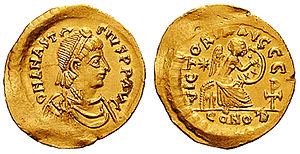This article needs additional citations for verification. (April 2019) |
| Millennium: | 1st millennium |
|---|---|
| Centuries: | |
| Decades: | |
| Years: |
| 491 by topic |
|---|
| Leaders |
| Categories |
| Gregorian calendar | 491 CDXCI |
| Ab urbe condita | 1244 |
| Assyrian calendar | 5241 |
| Balinese saka calendar | 412–413 |
| Bengali calendar | −102 |
| Berber calendar | 1441 |
| Buddhist calendar | 1035 |
| Burmese calendar | −147 |
| Byzantine calendar | 5999–6000 |
| Chinese calendar | 庚午年 (Metal Horse) 3188 or 2981 — to — 辛未年 (Metal Goat) 3189 or 2982 |
| Coptic calendar | 207–208 |
| Discordian calendar | 1657 |
| Ethiopian calendar | 483–484 |
| Hebrew calendar | 4251–4252 |
| Hindu calendars | |
| - Vikram Samvat | 547–548 |
| - Shaka Samvat | 412–413 |
| - Kali Yuga | 3591–3592 |
| Holocene calendar | 10491 |
| Iranian calendar | 131 BP – 130 BP |
| Islamic calendar | 135 BH – 134 BH |
| Javanese calendar | 377–378 |
| Julian calendar | 491 CDXCI |
| Korean calendar | 2824 |
| Minguo calendar | 1421 before ROC 民前1421年 |
| Nanakshahi calendar | −977 |
| Seleucid era | 802/803 AG |
| Thai solar calendar | 1033–1034 |
| Tibetan calendar | 阳金马年 (male Iron-Horse) 617 or 236 or −536 — to — 阴金羊年 (female Iron-Goat) 618 or 237 or −535 |

Year 491 (CDXCI) was a common year starting on Tuesday (link will display the full calendar) of the Julian calendar. At the time, it was known as the Year of the Consulship of Olybrius without colleague (or, less frequently, year 1244 Ab urbe condita). The denomination 491 for this year has been used since the early medieval period, when the Anno Domini calendar era became the prevalent method in Europe for naming years.